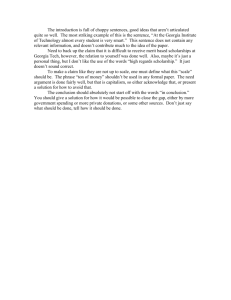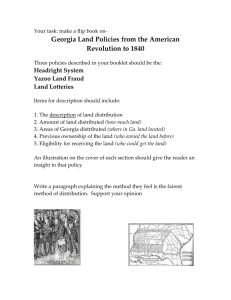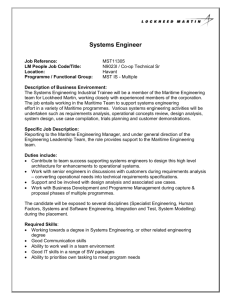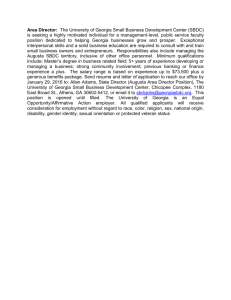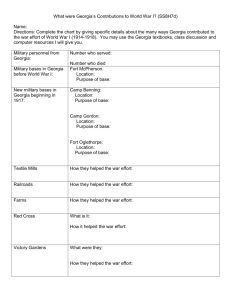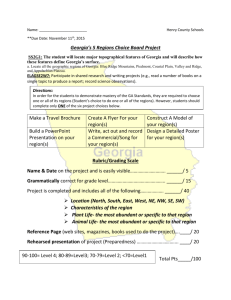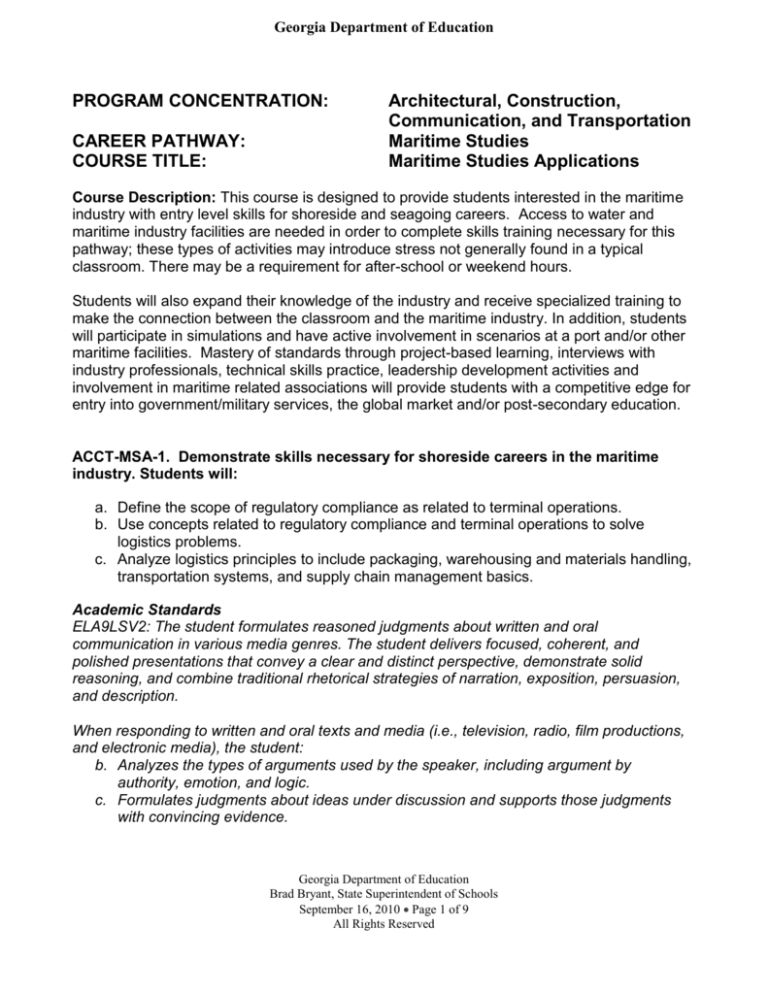
Georgia Department of Education
PROGRAM CONCENTRATION:
CAREER PATHWAY:
COURSE TITLE:
Architectural, Construction,
Communication, and Transportation
Maritime Studies
Maritime Studies Applications
Course Description: This course is designed to provide students interested in the maritime
industry with entry level skills for shoreside and seagoing careers. Access to water and
maritime industry facilities are needed in order to complete skills training necessary for this
pathway; these types of activities may introduce stress not generally found in a typical
classroom. There may be a requirement for after-school or weekend hours.
Students will also expand their knowledge of the industry and receive specialized training to
make the connection between the classroom and the maritime industry. In addition, students
will participate in simulations and have active involvement in scenarios at a port and/or other
maritime facilities. Mastery of standards through project-based learning, interviews with
industry professionals, technical skills practice, leadership development activities and
involvement in maritime related associations will provide students with a competitive edge for
entry into government/military services, the global market and/or post-secondary education.
ACCT-MSA-1. Demonstrate skills necessary for shoreside careers in the maritime
industry. Students will:
a. Define the scope of regulatory compliance as related to terminal operations.
b. Use concepts related to regulatory compliance and terminal operations to solve
logistics problems.
c. Analyze logistics principles to include packaging, warehousing and materials handling,
transportation systems, and supply chain management basics.
Academic Standards
ELA9LSV2: The student formulates reasoned judgments about written and oral
communication in various media genres. The student delivers focused, coherent, and
polished presentations that convey a clear and distinct perspective, demonstrate solid
reasoning, and combine traditional rhetorical strategies of narration, exposition, persuasion,
and description.
When responding to written and oral texts and media (i.e., television, radio, film productions,
and electronic media), the student:
b. Analyzes the types of arguments used by the speaker, including argument by
authority, emotion, and logic.
c. Formulates judgments about ideas under discussion and supports those judgments
with convincing evidence.
Georgia Department of Education
Brad Bryant, State Superintendent of Schools
September 16, 2010 Page 1 of 9
All Rights Reserved
Georgia Department of Education
SCSh6: Students will communicate scientific investigations and information clearly.
a. Use data as evidence to support scientific arguments and claims in written or oral
presentations.
SCSh9: Students will enhance reading in all curriculum areas by:
a. Read technical texts related to various subject areas.
ACCT-MSA-2. Demonstrate skills necessary for employment in the various seagoing
(deckside) careers in the maritime industry. Students will:
a. List and explain the purpose of various vessel markings, including loadline and plimsol
marks, draft marks, International Maritime Organization (IMO) number, vessel name,
home port, symbols, etc.
b. Given barometric pressure readings, interpret generally anticipated changes in
weather conditions.
c. Differentiate between various maritime lines and their intended use.
d. Employ proper line handling and knot tying for anchoring and mooring situations.
e. Navigate a vessel using simulator software according to a given scenario.
Academic Standards
ELA9LSV1: The student participates in student-to-teacher, student-to-student, and group
verbal interactions. The student
a. Initiates new topics and responds to adult-initiated topics.
b. Asks relevant questions.
c. Responds to questions with appropriate information.
d. Actively solicits another person’s comments or opinions.
e. Offers own opinion forcefully without domineering.
ACCT-MSA-3. Demonstrate skills necessary for employment in the various seagoing
(engineering) careers in the maritime industry. Students will:
a. Calculate and measure voltage, resistance and amperage in basic electrical systems.
b. Explain and demonstrate the impact of loading an item to a specific location in
relationship to vessel stability and the basic principles of center of gravity, weight,
buoyancy and external forces.
c. Develop an understanding of onboard electrical system requirements and power
generation and distribution.
d. Describe the principle of cathodic protection.
e. Detail the importance of and exercise preventative maintenance schedules for
maritime equipment.
Georgia Department of Education
Brad Bryant, State Superintendent of Schools
September 16, 2010 Page 2 of 9
All Rights Reserved
Georgia Department of Education
f. Outline cause and effect of failure to follow preventative maintenance schedules in
relationship to equipment degradation and the resulting cascading impacts if not
followed.
g. Given a ship’s systems diagram and color scheme, participate in locating equipment
including machinery, valves, and piping.
h. Under supervision at a maritime facility, participate in the operation of a vessel’s
firefighting system.
i. Sketch a ship’s system to include the firefighting system, lube/oil system, diesel
system, electrical system, etc.
Academic Standards
MM2A2: Students will explore exponential functions.
a. Extend properties of exponents to include all integer exponents.
e. Understand and use basic exponential functions as models of real phenomena.
MM2P2: Students will reason and evaluate mathematical arguments.
b. Make and investigate mathematical conjectures.
c. Develop and evaluate mathematical arguments and proofs.
MM2P3: Students will communicate mathematically.
a. Organize and consolidate their mathematical thinking through communication.
d. Use the language of mathematics to express mathematical ideas precisely.
MM2P4: Students will make connections among mathematical ideas and to other disciplines.
a. Recognize and use connections among mathematical ideas.
b. Understand how mathematical ideas interconnect and build on one another to produce
a coherent whole.
c. Recognize and apply mathematics in contexts outside of mathematics.
MM2P5: Students will represent mathematics in multiple ways.
a. Create and use representations to organize, record, and communicate mathematical
ideas.
b. Select, apply, and translate among mathematical representations to solve problems.
c. Use representations to model and interpret physical, social, and mathematical
phenomena.
SCSh2: Students will use safety standard practices for all classroom laboratory and field
investigations.
a. Follow correct protocol for identifying and reporting safety problems and violations.
SCSh8: Students will understand important features of the process of scientific inquiry.
c. Scientists use practices such as peer review and publication to reinforce the integrity
of scientific activity and reporting.
Georgia Department of Education
Brad Bryant, State Superintendent of Schools
September 16, 2010 Page 3 of 9
All Rights Reserved
Georgia Department of Education
d. Science disciplines and traditions differ from one another in what is studied,
techniques used, and outcomes weighed.
ACCT-MSA-4. Demonstrate skills related to firefighting in the maritime industry.
Students will:
a. Apply knowledge to practical application of fire hoses, nozzles, streams, and foam,
including fire hydraulics, fire hoses, hose care, maintenance, inspection, hose
appliances, hose rolls, fire hose evolutions, nozzles, etc.
b. Compare and contrast fire suppression operations and understand offensive versus
defensive operations, including operating hose lines, protecting exposures, jettisoning,
and fire classification.
c. Classify by function and demonstrate proficiency in the use of fire fighter tools and
equipment, including functions, phases of use, tool staging and maintenance.
d. Demonstrate proper use and knowledge of classification of fire extinguishers, fire
extinguisher placement, methods of fire extinguishments, types of extinguishing
agents, fire extinguisher design/characteristics, and care of fire extinguishers.
Academic Standards
ELA9W3: The student uses research and technology to support writing.
a. Formulates clear research questions and utilizes appropriate research venues (i.e.,
library, electronic media, personal interview, survey) to locate and incorporate
evidence from primary and secondary sources.
b. Uses supporting evidence from multiple sources to develop the main ideas within the
body of an essay, composition, or technical document.
c. Synthesizes information from multiple sources and identifies complexities and
discrepancies in the information and the different perspectives found in each medium
(i.e., almanacs, microfiche, news sources, in-depth field studies, speeches, journals, or
technical documents).
SCSh1: Students will evaluate the importance of curiosity, honesty, openness, and
skepticism in science.
a. Exhibit the above traits in their own scientific activities.
SCSh5: Students will demonstrate the computation and estimation skills necessary for
analyzing data and developing reasonable scientific explanations.
a. Trace the source on any large disparity between estimated and calculated answers to
the problem.
b. Consider possible effects of measurement errors on calculations.
c. Recognize the relationship between accuracy and precision.
d. Express appropriate numbers of significant figures for calculated data, using scientific
notation where appropriate.
Georgia Department of Education
Brad Bryant, State Superintendent of Schools
September 16, 2010 Page 4 of 9
All Rights Reserved
Georgia Department of Education
ACCT-MSA-5. Demonstrate knowledge and skills necessary for dealing with
hazardous materials, including hazardous communications, proper handling and
disposal, and response to unintended release. Students will:
a. List and define available reference information relating to hazmat, including MSDS,
Emergency Response Guidebook, manufacturers’ websites, etc.
b. Detail the importance of segregation of cargo, including container separation, bulk
liquid separation, and cross contamination.
c. Given a scenario develop a response plan to include scene control, safety
precautions/procedures, and levels of damage caused by chemicals.
d. Determine personal protective equipment for handling hazmat and responding to
hazmat situations.
Academic Standards
ELA9RC3: The student acquires new vocabulary in each content area and uses it correctly.
a. Demonstrates an understanding of contextual vocabulary in various subjects.
b. Uses content vocabulary in writing and speaking.
ACCT-MSA-6. Demonstrate skills necessary for communications in all aspects of
maritime activity. Students will:
a. Identify communications protocol to include terminology, equipment, radio channel
purpose, and secure and unsecure operation.
b. Operate shipboard communication equipment to include voice tubes, messengers,
public address system, call box, Very High Frequency (VHF) Radio, Single-Sideband
radio, Emergency Position Indicating Radio Beacon (EPIRB).
Academic Standards:
ELA9RC4: The student establishes a context for information acquired by reading across
curriculum.
a. Explores life experiences related to subject area content.
b. Discusses in both writing and speaking how certain words and concepts relate to
multiple subjects.
ELA9W2: The student demonstrates competence in a variety of genres –specifically
informational (expository) writing and technical writing.
The student produces expository (informational) writing to convey information and ideas from
primary and secondary sources accurately and coherently; the student:
a. Engages the interest of the reader.
Georgia Department of Education
Brad Bryant, State Superintendent of Schools
September 16, 2010 Page 5 of 9
All Rights Reserved
Georgia Department of Education
b. Formulates a coherent thesis or controlling idea.
c. Coherently develops the controlling idea and/or supports the thesis by incorporating
evidence from at least one secondary source.
d. Follows an organizational pattern appropriate to the type of composition.
ACCT-MSA-7. Demonstrate skills necessary for preventing and responding to
emergencies. Students will:
a. List and define preventative measures for emergencies, including the process of
securing for sea and reviewing assigned emergency responsibilities
b. Given a scenario, assess unsecure items and determine appropriate procedure for
making items secure.
c. Demonstrate proper response to man overboard, taking on water, and abandon ship
emergencies.
d. Perform tests associated with water survival skills.
Academic Standards:
ELA9C1: The student demonstrates understanding and control of the rules of the English
language, realizing that usage involves the appropriate application of conventions and
grammar in both written and spoken formats.
a. Demonstrates an understanding of proper English usage and control of grammar,
sentence and paragraph structure, diction, and syntax.
b. Correctly uses clauses (i.e., main and subordinate) and mechanics of punctuation (i.e.
end marks, commas, semicolons, and quotation marks).
c. Demonstrates an understanding of sentence construction (i.e., subordination, proper
placement of modifiers) and proper English usage (i.e., consistency of verb tenses).
ACCT-MSA-8. Demonstrate skills associated with the familiarization and utilization of
maritime reference manuals. Students will:
a. Plan a trip and simulate navigation to a specific location utilizing Light Lists/List of
Lights, Coast Pilots/Sailing Directions, Tide Tables/Tidal Current Tables, nautical
charts, bearings, GPS readings, and plotting equipment.
b. Apply navigational rules, while on a simulated trip to include steering and sailing rules,
lights and shapes, sound and light signals and exemptions.
ACCT-MSA-9. Demonstrate knowledge of shipboard watchkeeping. Students will:
a. Explain fitness for duty, watch arrangements/principles, certification, and voyage
planning related to watchkeeping international standards.
Georgia Department of Education
Brad Bryant, State Superintendent of Schools
September 16, 2010 Page 6 of 9
All Rights Reserved
Georgia Department of Education
b. Interpret international standards for watchkeeping at sea to include navigational watch,
engineering watch, and radio watch.
c. Compare and contrast watchkeeping at sea with watchkeeping in port to include watch
arrangements, taking over the watch, performing the watch, and watchkeeping
conditions.
Reading Across the Curriculum
Reading Standard Comment
After the elementary years, students engage in reading for learning. This process sweeps
across all disciplinary domains, extending even to the area of personal they experience text
in all genres and modes of discourse. In the study of various disciplines of learning
(language arts, mathematics, science, social studies), students must learn through reading
the communities of discourse of each of those disciplines. Each subject has its own specific
vocabulary, and for students to excel in all subjects, they must learn the specific vocabulary
of those subject areas in context.
Beginning with the middle grades years, students begin to self-select reading materials based
on personal interests established through classroom learning. Students become curious
about science, mathematics, history, and literature as they form contexts for those subjects
related to their personal and classroom experiences. As students explore academic areas
through reading, they develop favorite subjects and become confident in their verbal
discourse about those subjects.
Reading across curriculum content develops both academic and personal interests in
students. As students read, they develop both content and contextual vocabulary. They also
build good habits for reading, researching, and learning. The Reading Across the Curriculum
standard focuses on the academic and personal skills students acquire as they read in all
areas of learning.
Students will enhance reading in all curriculum areas by:
a. Reading in all curriculum areas
Read a minimum of 25 grade-level appropriate books per year from a
variety of subject disciplines and participate in discussions related to
curricular learning in all areas.
Read both informational and fictional texts in a variety of genres and
modes of discourse.
Read technical texts related to various subject areas.
Georgia Department of Education
Brad Bryant, State Superintendent of Schools
September 16, 2010 Page 7 of 9
All Rights Reserved
Georgia Department of Education
b .Discussing books
Discuss messages and themes from books in all subject areas.
Respond to a variety of texts in multiple modes of discourse.
Relate messages and themes from one subject area to messages and
themes in another area.
Evaluate the merit of texts in every subject discipline.
Examine author’s purpose in writing.
Recognize the features of disciplinary texts.
c. Building vocabulary knowledge
Demonstrate an understanding of contextual vocabulary in various
subjects.
Use content vocabulary in writing and speaking.
Explore understanding of new words found in subject area texts.
d. Establishing context
Explore life experiences related to subject area content.
Discuss in both writing and speaking how certain words are subject
area related.
Determine strategies for finding content and contextual meaning for
unknown words.
CTAE Foundation Skills
The Foundation Skills for Career, Technical and Agricultural Education (CTAE) are critical
competencies that students pursuing any career pathway should exhibit to be successful. As
core standards for all career pathways in all program concentrations, these skills link career,
technical and agricultural education to the state’s academic performance standards.
The CTAE Foundation Skills are aligned to the foundation of the U. S. Department of
Education’s 16 Career Clusters. Endorsed by the National Career Technical Education
Foundation (NCTEF) and the National Association of State Directors of Career Technical
Education Consortium (NASDCTEc), the foundation skills were developed from an analysis
of all pathways in the sixteen occupational areas. These standards were identified and
validated by a national advisory group of employers, secondary and postsecondary
educators, labor associations, and other stakeholders. The Knowledge and Skills provide
learners a broad foundation for managing lifelong learning and career transitions in a rapidly
changing economy.
Georgia Department of Education
Brad Bryant, State Superintendent of Schools
September 16, 2010 Page 8 of 9
All Rights Reserved
Georgia Department of Education
CTAE-FS-1 Technical Skills: Learners achieve technical content skills necessary to pursue
the full range of careers for all pathways in the program concentration.
CTAE-FS-2 Academic Foundations: Learners achieve state academic standards at or
above grade level.
CTAE-FS-3 Communications: Learners use various communication skills in expressing and
interpreting information.
CTAE-FS-4 Problem Solving and Critical Thinking: Learners define and solve problems,
and use problem-solving and improvement methods and tools.
CTAE-FS-5 Information Technology Applications: Learners use multiple information
technology devices to access, organize, process, transmit, and communicate information.
CTAE-FS-6 Systems: Learners understand a variety of organizational structures and
functions.
CTAE-FS-7 Safety, Health and Environment: Learners employ safety, health and
environmental management systems in corporations and comprehend their importance to
organizational performance and regulatory compliance.
CTAE-FS-8 Leadership and Teamwork: Learners apply leadership and
teamwork skills in collaborating with others to accomplish organizational goals and
objectives.
CTAE-FS-9 Ethics and Legal Responsibilities: Learners commit to work ethics, behavior,
and legal responsibilities in the workplace.
CTAE-FS-10 Career Development: Learners plan and manage academic-career plans and
employment relations.
CTAE-FS-11 Entrepreneurship: Learners demonstrate understanding of concepts,
processes, and behaviors associated with successful entrepreneurial performance.
Georgia Department of Education
Brad Bryant, State Superintendent of Schools
September 16, 2010 Page 9 of 9
All Rights Reserved

